Magic Tricks With Cards: How to Create Astonishing Routines with our 3 Trick Miracle Template
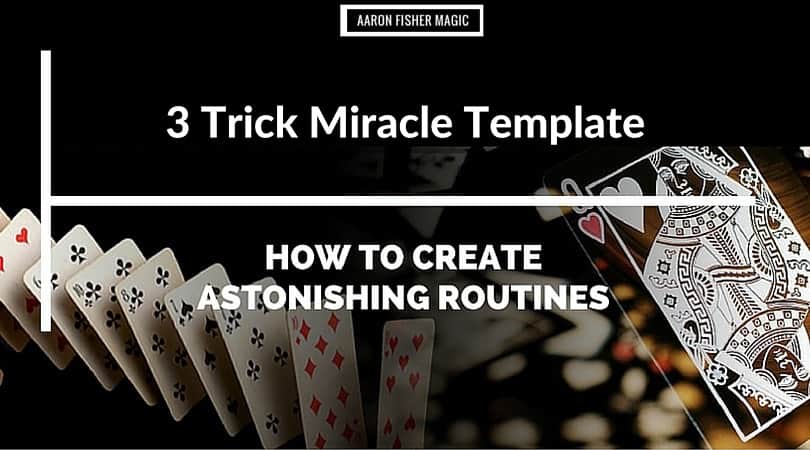
After you’ve been in magic awhile, and you know at least a handful of magic tricks with cards, the question always comes up, “How do I take these tricks and put them together into a routine?”.
This problem arises for all magicians and it can be a real challenge to solve. Michael Skinner often recommended that magicians make a list of all their tricks, and then arrange them in groups of three effects that seem to work well together. This is great advice, and there are many combinations that work…especially when it comes to magic tricks with cards.
However, my own experience of 20 years performing magic – and 10 of those years working only with a deck of cards, is that it IS challenging to find sequences that really work.
What does that mean..’really work’?
Magic Routines Designed to Transform Strangers into Astonished Fans
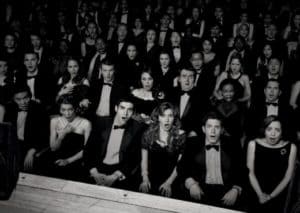
It means that we don’t just want three magic tricks that go together in theory. We want a sequence of tricks that we can rely on, in any situation, to penetrate a group of potentially disinterested spectators and:
- In the first trick, grab their attention quickly and effectively
- In the second, turn that attention into a magical experience
- Finally, ensure that everyone ‘is in’ on the third and final trick, and gets the full ‘magical experience’ it has to offer.
Finding three tricks that do that for you with regularity and predictability can be a major challenge. Once you have those three magic tricks, you’ll always be ready to perform with confidence – because you know you can access a complete ‘set’ of powerful close-up magic that:
- Has a clear beginning, middle and end
- Has the desired impact on the audience just about every time
Some Magicians Supplies Always Get A Strong Reaction
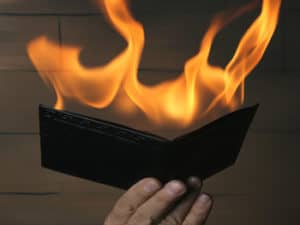
As I look at my own repertoire, there are many professional tricks, like any version of Fred Kaps Flash Cash – where blank paper or 1$ bills turn into a stack of $100 dollar bills, or the renowned Fire Wallet, which can open any crowd, even in the most difficult professional close-up conditions. After all, there’s no better way to get people to turn their attention toward you than by approaching them with a flaming object.
I’ve used both of these items to open professional close-up sets for ‘cold audiences’, because they get the attention of the crowd in a moment, and give me the space I need to work.
How To Build A Great Routine with An Ordinary Deck of Cards
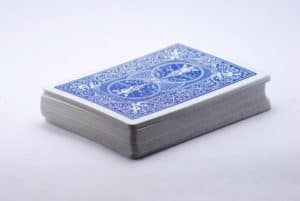
I’ve been known for my whole career as a magician who does magic tricks with cards…I’ve often found myself without gaffed bills or exploding wallets.
On thousands of occasions, I’ve been asked to perform for tough crowds using nothing but an ordinary pack of playing cards.
The formula you’re about to discover gets the job done, using only an ordinary pack of cards, every time. I know this works not because I reviewed all of my close-up card material from the last 20 years, and a specific pattern jumped out at me. It was easy to see. And it’s been there the whole time.
The 3 Part Template creates a framework that ensures you’ll always have a sure-fire way to:
- Open strong and fast with an ordinary deck
- Escalate the magic experience
- Engage the audience and build their attention throughout the middle of the routine
- Bring the set to a satisfying conclusion for everyone present!
The Magician’s ‘3 Trick Miracle Template’
Mental-Tactile-Visual (M-T-V)
Mental-Tactile-Visual (M-T-V)
It’s goes like this.
Trick 1: Mental

After twenty years performing magic, I know of no faster way of getting an audience’s attention then to have someone think of a card…and then tell them what it is.
If you’ve been in magic awhile, you may think the only way to make this effect powerful is to use a psychological force of some kind. In the hands of a master like Steve Valentine, Asi Wind or Berglass – there’s no doubt this kind of ‘think a card’ trick has unusual power.
However, these forces are very difficult to use with confidence. They’re never 100% and will always involve the use of ‘multiple outs’ (branching methods to bring the effect to a successful conclusion).
I love these sort of methods, but please don’t think they’re essential. They aren’t. In fact, your Mental Card Opener can be extremely easy to do. Remember, directness is the key to the opening.
So I suggest you…
Use A Simple Card Force
Provided your card force is fair, direct and unsuspicious, and your audience hasn’t just seen one of the three masters I just mentioned, a simple Crossing-the-Cut Force of the sort you can find in my Easy Card Tricks article will be more than strong enough to connect with a spectator and ‘open’ your set.
Remember, the audience has barely met you. Most of the time, they’re not focused on your performance enough to appreciate the subtleties we magicians so appreciate in the more advanced methods.
Here’s a sample presentation that many top pros use all the time. I suggest you try it out, and experience for yourself how powerful and direct it is – and how well it works to ‘open’ a crowd:
“Just say stop and think about that card. Say it’s name to yourself over and over and over again…”
As you say these words, beginning nodding your head. You’ll see the spectator begin silently repeating the name of the card his mind, and as she does this, let your eyes ‘light up’ as you say…
“Ace of hearts, Ace of Hearts, Ace of Hearts”.
Most of the time, the spectator smiles and even starts laughing out loud. In effect, it feels to her that you’ve actually heard her thoughts!
But in terms of the Routine Template, at least one audience member has felt direct impact and surprise – and enjoyed it.
Everyone else can see the effect written on her face, and at the bare minimum, wonders about the experience that just made their friend so happy. Most of the time, people in the group are beginning to wonder if they might experience something fun themselves…
And YOUR foot is in the door.
Trick 2: Tactile
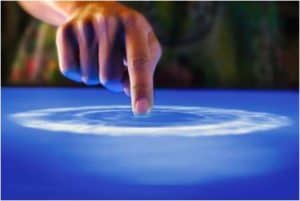 Now that you have everyone’s attention, use a trick that engages one or more of the audience members directly. If possible, do a trick where the magic actually happens in the spectator’s hands.
Now that you have everyone’s attention, use a trick that engages one or more of the audience members directly. If possible, do a trick where the magic actually happens in the spectator’s hands.
That’s why we label the second trick TACTILE. Because the audience starts to play with you – touch the cards, and feel the magic.
Try something as simple as changing a random card into a selection while a person holds it in her hand. Or an Ambitious Card sequence that takes place in a spectator’s hands.
It’s up to you – but the key here is to make sure that other people, preferably most or all of your close-up audience, gets to physically touch cards and participate in the magic.
For our example here, try this easy to do effect that not only gets a great reaction, but will show you the astonishing impact of a trick that happens in the spectator’s hands.
Tactile Turnover
Effect
The spectator is then instructed to imagine the kings turning over in the pack. When she spreads the cards, she’s astonished to discover that the four kings have turned face-up under impossible conditions.
Explanation
Start by turning the pack face toward yourself as you raise the cards up to spread through the pack.
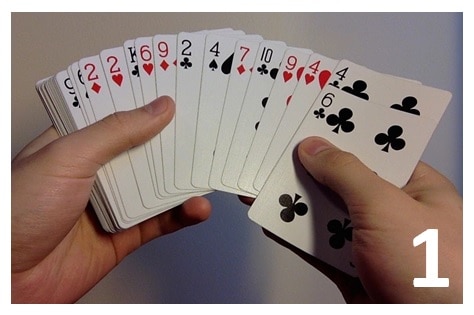
Keep spreading until you see the first king, at which point you raise all the cards in your left hand, including the king, up to the point where your first finger of the right hand can clamp down on the bottom edge of the king and hold it, up-jogged, against the right hand cards. See Pic 2.
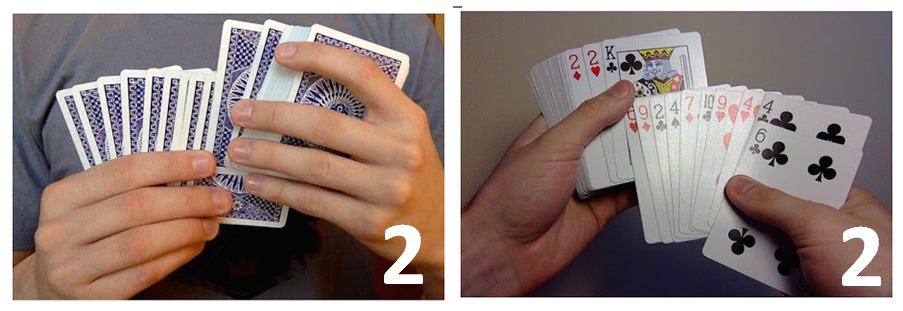
Use the right first finger to maintain the up-jogged condition of the first king as you lower the left hand cards and continue to spread through the pack. After you spread a few cards more, you’ll find the king will be held in place by the cards around it, and once that happens, you can release your first finger from the king and use it to support all the right hand cards.
Repeat the same procedure with the other 3 kings and leave them all up-jogged as you square up the deck into your left hand.
If you find the down-jogged card on the face of the deck wants to move around too much as you spread and then square the cards, use the tip of your right fourth finger to contact the face of the card. With just a little pressure from the fourth finger, you’ll find the card stays in it’s down-jogged position even as you square the pack and leave the kings up-jogged.
At this point you should have four kings out-jogged and one in-jogged card in your left hand. See Pic 3.
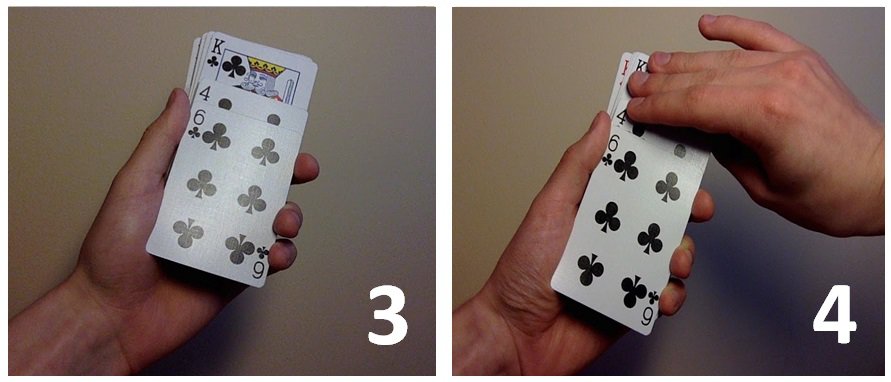
Rotate your right palm towards the audience so that you can contact the backs of the out-jogged cards with your right thumb and with your fingers on their faces. Pinch the four kings together and lift them up out of the deck. See Pic 4.
As they clear the pack, rotate your right hand to display their faces.
Use the right thumb to spread the kings upward and give the audience a clear “mental snapshot” of the kings. As you’ll see in a moment, the slightly vertical nature of the spread will help your deception shortly. See Pic 5.
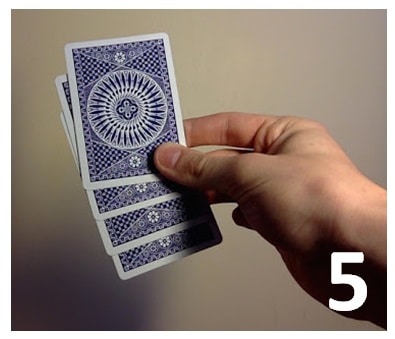
Lower both hands and replace the kings back on the deck, face-down, so that the spread covers the in-jogged card. See Pic 6.
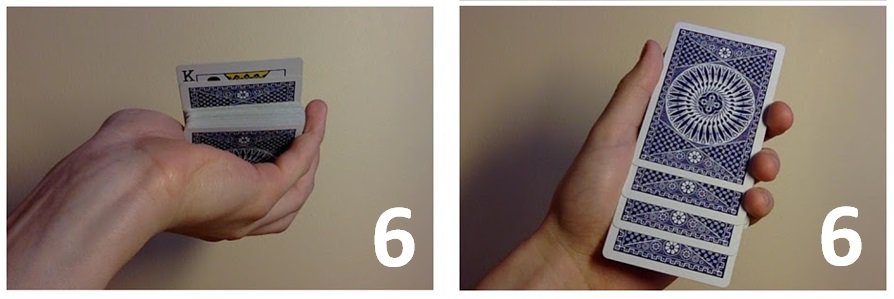
As your right hand squares the spread packet, use your right thumb to contact the in-jog and lift up on it. This creates a break between the jogged card and the rest of the pack. Now you can easily add this card, still face up, onto the face down king packet as you lift the squared king packet away from the deck. See Pic 7.
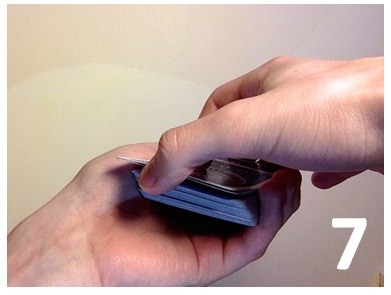
Use the left thumb to re-take and hold the packet side-jogged by half it’s width on top of the pack.
All of this action take but a few moments in actual performance.
Ask a spectator to extend their right hand palm up – gesturing with your right hand palm up as an example. See Pic 8.
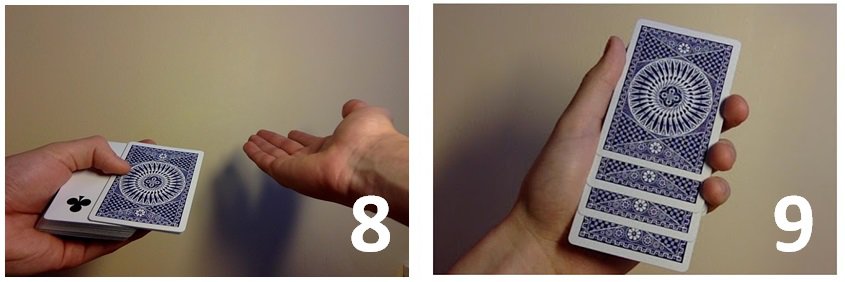
As they follow your direction, your palm up right hand takes the 5 card packet from below using your thumb and second finger (See Pic 9) and place the face-up deck in their outstretched palm.
Now you’ll create cover for the secret reversal of your right hand packet.
Say, “That’s almost perfect. Put the pack in your left hand, face down, like you’re about to deal a game of cards. ”
As you give these instructions, you’ll look over to the spectator’s left hand. Let your right hand relax and turn palm down as you drop the packet into your left hand dealing position in-transit. See Pic 10.

This action will never be noticed, thanks to several factors. First, the spectator has clear direction which will require her focus. Everyone present is listening too. Next, your right hand action helps make the instructions clear.
In order to ensure your right hand action doesn’t draw any suspicion, focus only on your right hand open-action. In your mind, don’t even think of the packet. Simply put the cards in your left hand (face-down of course) as you free your right hand to freely point toward spectator’s empty hand. See Pic 11.
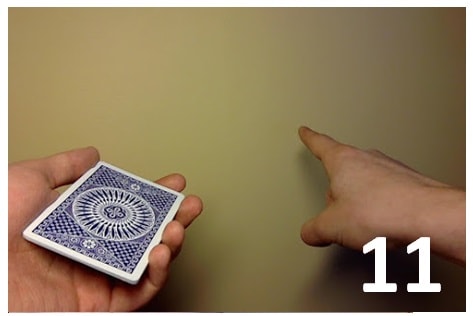
This secret reverse isn’t really a sleight – but it’s very powerful and deceptive.
Nothing is left for you to do but create the mysterious effect of the four king reversal. Ask your spectator to cut off the top half of the pack from above. As she does, your right hand takes the packet and places it square on top of the bottom half of the deck.
The illusion of 4 face down kings going into the center of the pack is powerful. Simply ask your participant to replace the top half of the cards on the bottom half, and ask her to imagine the four kings turning themselves over…
After a moment of mystery, ask her to spread the cards on the table, or better, between her hands, and she’ll discover the 4 kings have actually turned face-up under challenge conditions.
Trick 3: Visual
 Now that you’ve astounded the audience twice, and ensured that you have everyone’s participation and attention, it’s safe to perform a visual effect. Now, EVERYONE can experience the magic at the same time.
Now that you’ve astounded the audience twice, and ensured that you have everyone’s participation and attention, it’s safe to perform a visual effect. Now, EVERYONE can experience the magic at the same time.
At the same time, putting the Visual element ‘late’ in the three effect order has given you the time, and mystery, required to create magic atmosphere. Now your visual effect won’t get you dismissed for ‘tricky fingers’ before you’ve even begun!
The following is one of my favorite effects. It’s a visual full deck reversal that takes place all at once – and creates a powerful effect on the audience. While there are many advanced methods for reversed card effects, such as methods that use my own gravity half pass, this one is very easy to do – and best of all, it expands on the second trick to create a feeling of escalating magic and astonishment.
The Total Turnover
Effect
A spectator picks a card and shows it to everyone. You offer to perform the ‘magic reversal’ under test conditions: the selection will remain sticking out of the pack in full view so it can be seen at all times.
Now, with everyone watching closely, every card in the pack visibly turns face-up around the selection. The effect mysterious, visual and astounding.
Explanation
Let a spectator pick a card and turn away as you say: “Show it to everyone. I won’t look!”.
As you turn away, you have all the cover and misdirection you could ever need.
Use your right hand to take the top two cards off the deck and at the same time, put your left thumb beneath the deck and flip it over. See Pic 12.
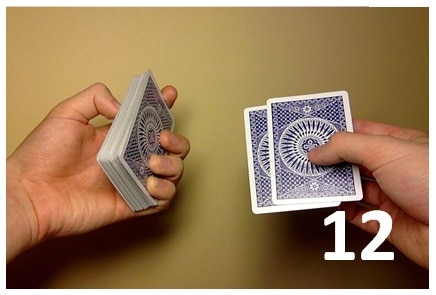
Drop the right hand cards face-down on the now face-up deck and the work is complete. Turn to face the audience, and it looks as though you have a face-down deck in your hand just as before.
Take the selection back and insert it face down into the seemingly face-down pack. Leave it sticking out of the pack and if you wish, ask a spectator to lightly hold it in that position.
Let the audience know that even under these impossible conditions, the selection will be the only card reversed in the deck.
Take the top card in the right and and turn it gently face-up onto the deck, back-jogged for half its length. See Pic 13.
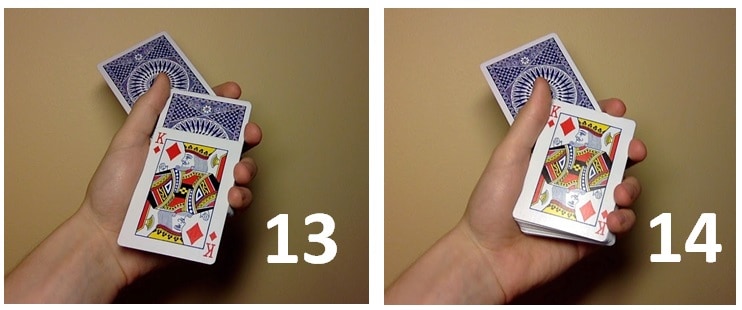
As everyone looks on, allow the face-up card to slide forward and square with the rest of the pack.. See Pic 14.
You now have a face-up card, followed by a face-down card, followed by the rest of the deck face-up (and a face-down selection sticking out of the deck).
Snap your fingers and let the spectator know that the magic has happened. Of course, they won’t believe you, at which point you will cock back your left thumb and use it to perform a block push off to conceal the single face-down card second from the top of the pack.
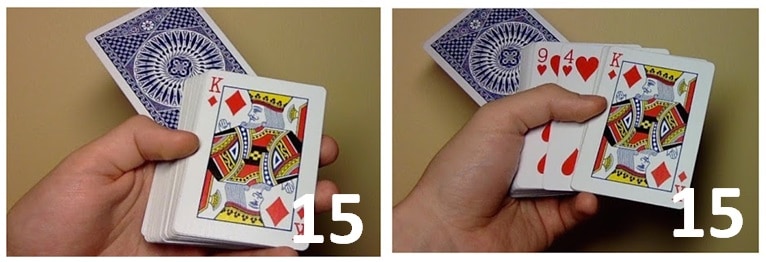
To perform the block push off, bevel the pack to the right and pull your thumb back to about the middle of the long edge. The angle between the tip of your thumb and the long edge of the deck should be around 90 degrees (See Pic 15). Use the cuticle on the side of your thumb to contact a packet of no more than 5-10 cards and push it off to the side and keep spreading the rest of the deck. As you practice, you’ll be able to confidently push over a block of 3-5 cards without fear of exposing the face-down card (See Pic 16), but don’t rush it. Even with a larger block, the trick is still astounding.
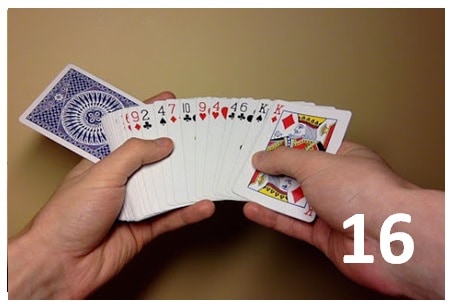
The block push-off is only the first action of the revelation. The audience will be surprised the moment you begin to push face-up cards off the deck. Their amazement grows and grows as you continue spreading the cards to reveal the ultimate finale – the entire pack, except for the selection, has visually turned face-up! See Pic 17.
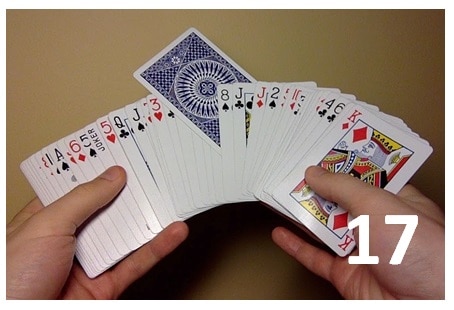
Magic Tricks With Cards: The Versatile Miracle Card Trick Routine
You’ll never find an easier method to create a variety of routines that always play, even for the toughest audiences.
You can likely start using the 3-Step Template right now with tricks you already love.
Just remember, even though we’ve shared some very powerful tricks, you can use this template to create many different combinations and routines. The 3 Step Template gives you ‘pillars’ you can use to structure your card routine, but you can always add tricks, phases or diversions between any, and every, part of the template.
And thanks to the stages of engagement and amazement established in each stage of the M-T-V template, you’ll always know that the shape of your impromptu card routine provides a structure that will open your set effectively, build attention, interest and engagement – and build to a satisfying conclusion that even the toughest audience will love.